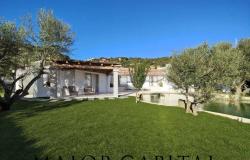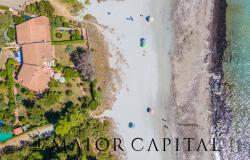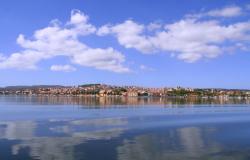The road twists and turns up a steep hillside behind the tiny village of Domus de Maria. At every bend, a glimmering sea, wrapped in the soft pink haze of distance, plays a game of hide and seek with the peaks, while the waterside scrubland rarefies, replaced by the round, robust solidity of chestnut trees and holm oaks.
We are on our way to Is Cannoneris, one of Europe’s largest holm-oak forests. As we climb up, the air becomes cooler and the woods thicker, an ocean of green occasionally broken by whimsical outcrops rising sharply from the ground. The only reminder that we are in scorching hot Sardinia are the fuel breaks, patches of bare land cleared among the trees to reduce the risk of fire, and the odd water cistern to feed fire-fighting hoses.
Up and up we go, and only meet a herd of white, bearded goats, bells jingling as they furiously munch the grass. This is a wild place—so wild that road signs are scarce and several times during the forty-five minutes drive we wonder whether we are going in the right direction.
Compared to the road, the forest’s entrance at the top of the hill is surprisingly tame—a wrought-iron gate, flagstone paths, a lush lawn bordered by neatly trimmed hedges, and the one building for miles, an old ranger’s house which is being turned into a visitors’ centre.
But first impressions are deceiving. The gate only leads to an enclosure where a herd of Sardinian deer—an indigenous species that was once under threat of extinction, but is now thriving in good numbers— lie indolently in the shade, barely lifting their antlered heads to look at the strangers that encroach on their territory. Only a young buck trying to jump the queue for the trough spurs the alpha stag into action. Head bent, he gives the buck a quick push, thus re-establishing his supremacy, and his right to drink first.
The forest itself stretches deep, wild and enormous to the right of the deer enclosure, beyond the picnic area. Narrow paths weave their way among the thick trees, cutting across a dark undergrowth of moss-encrusted rocks, rustling ferns and fallen branches. They are alive with birds chirping, insects scurrying, water falling, leaves crackling—and completely devoid of human presence, once we leave behind the builders who are fixing the visitors’ centre at the entrance.
It wasn’t always like that. Is Cannoneris is an early conservation miracle. When the Italian state acquired it at the beginning of the 20th century, this was overgrazed, overfelled woodland, but a hundred years of careful, gentle care gave new life to holm oaks, junipers and strawberry-trees (glossy shrubs whose yellow and red berries have precious little in common with strawberries), turning the place into a wildlife haven.
Today, it is home to Sardinian and fallow deer, fox and wild boar, golden eagle and peregrine falcon. We fail spectacularly at catching sight of any of them beyond the deer in the enclosure—but then, travelling with a boisterous four-year-old who rides a pretend horse up and down the slopes to slay unseen enemies with every stick he can find on the ground is hardly conducive to wildlife spotting.
Stealthier, kid-free friends report seeing wild boar moving in the distance, falcons launching into flight off lofty branches and small, slender, wide-eyed deer drinking from a peaceful forest brook at sunset.
To reach Is Cannoneris, go to Domus de Maria (just under an hour’s drive from Cagliari on the SS195 road), then take the signposted Strada Montana per Is Cannoneris from Domus de Maria. Bring your own food and water for a picnic as there is no café. The nearest restaurant is an agriturismo, Sa Mitza e s’Orcu, some fifteen minutes’ drive down the road from Is Cannoneris, which also has six bedrooms (phone to book a meal: +39 070 9236207). The forest is criss-crossed by paths, bridleways and mountain bike trails. For those with enough stamina, there is also a bike trail that climbs all the way up the hill from the village of Villa San Pietro to Is Cannoneris. For more information call forest officials on +39 070 9270285.












